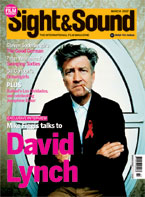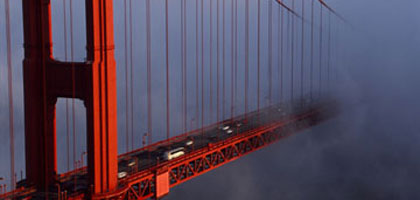Primary navigation

USA 2005

Reviewed by Ryan Gilbey
Our synopses give away the plot in full, including surprise twists.
A documentary about the popularity of San Francisco's Golden Gate Bridge as a site for suicide attempts. Interviews with the friends and families of some of the 24 people who died after jumping from the bridge in 2004 are intercut with footage of actual deaths. Also interviewed is Richard Waters, who prevented a woman from jumping, and Kevin Hines, who miraculously survived a leap. An end title reveals that more people have chosen to end their lives at the Golden Gate Bridge than anywhere else in the world.
There is no nice way of saying it: The Bridge is a downer. In the first few minutes of this documentary about the Golden Gate Bridge and its unenviable position as the world's number-one suicide hotspot, a white-haired man in a baseball cap hoists himself over the 4ft safety rail and drops to his death with a mixture of clumsiness and boredom.
Our longing to interrupt the ensuing showreel of suicides is superseded by our disbelief that the film-makers haven't themselves intervened, rather than concentrating their efforts on keeping the bodies, which plummet into the water at around 120mph, centre-screen. First-time director Eric Steel, a former Disney executive, stationed his cameras at various positions in view of the bridge and shot throughout 2004, during which there were 24 successful suicide attempts. The knowledge that he alerted the authorities whenever he saw someone behaving suspiciously hardly makes us feel better that the cameras kept rolling.
But this footage lends the picture a thematic force far beyond its initial shock value. The Bridge is an evocation of impotence in which powerlessness is manifested at every level, from the stories of the victims to the testimonies of the friends and families reduced to onlookers in the darkening lives of their loved ones, and finally to our blunt horror at watching strangers die. Impotence is a common feeling among cinema audiences, trapped in their seats and unable to influence the on-screen action, but that abstract discomfort is sharpened to its severest point in The Bridge.
Steel includes one story - the film's single uplifting episode - that provides a wry commentary on his own role and responsibilities as a film-maker. Richard Waters recounts how he was taking photographs on the bridge when a woman climbed on to the ledge. His first reaction was simply to continue snapping - and Steel films him doing just that. "When I was behind the camera, it was almost like it wasn't real 'cos I was looking through the lens," explains Waters, inadvertently articulating suspicions viewers may be harbouring about Steel. But Waters eventually heaved the woman back over the railing. You can forgive him for grabbing one last photograph of the would-be jumper's bitter, jutting face as she is bundled into the police car, since he overcame so boldly that feeling of insulation provided by the camera. He crossed the boundary between anthropological distance and subjective reality, and it's hard not to feel that by including this dramatic incident, suspensefully edited by Sabine Krayenbühl, Steel is expressing ambivalence about his own inability to do the same.
The rest of The Bridge replaces the gruesome details of Tad Friend's original New Yorker article, which inspired the film, with admissions of regret and frailty expressed by the families of the dead; refreshingly, Steel imposes no lunges towards bogus redemption other than the occasional cloying song (sample lyric: "At the end of our days, we'll escape"). All the testimonies are agonising. Particularly moving are the dazed comments of Philip Manikow's father, who remembers the conversations he had with his son about the ethics of suicide, which he now realises were the younger man's attempts to ask permission to kill himself. A single drop of rejuvenating humour comes in an interview with the Figueroa family, who were taking holiday pictures on the bridge when they witnessed a woman jumping. "She was acting like a gorilla or something," enthuses the youngest son, bursting to make his contribution. "He likes to make things up," says his mother, tightening with embarrassment.
The picture also touches tantalisingly on the special magnetism of the Golden Gate Bridge. "I thought it was kind of odd that he had that fascination," says Philip's mother. "It was almost like it was calling him." Steel reinforces this image of the structure as some kind of mystical entity by inserting shots of nearby towns where the bridge's towers loom in the distance. He reclaims the bridge from its iconic use in films like Vertigo and Dirty Harry by shooting from unusual angles. Shrouded in mist, or cutting a red scar across a lush blue sky, it is predictably eerie. Up close, we see the grimy ledge where jumpers have their last chance of a U-turn. The only let-down is the time-lapse photography, a device so hackneyed in the wake of Godfrey Reggio that it should be strictly regulated by some official body.